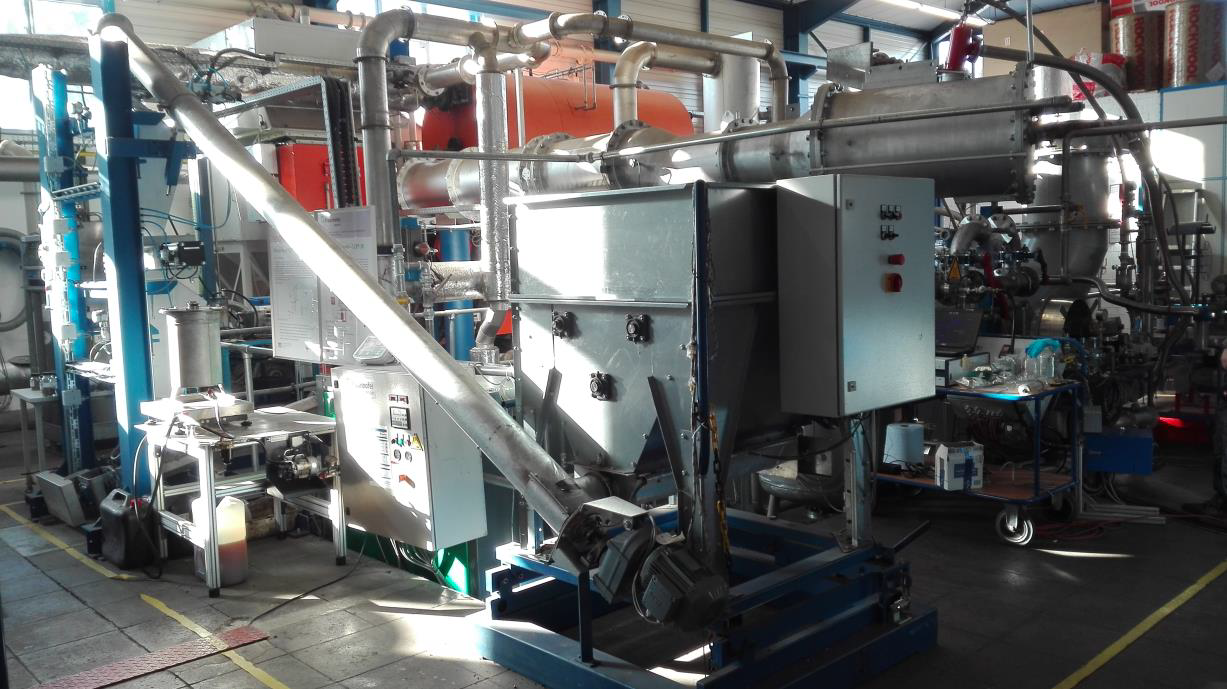TCR - Thermocatalytic Reforming
Period: 2017

Contents
The objective of the experiment performed was to test the performance of the TCR (thermocatalytic reforming) technology present in a pilot plant at the Fraunhofer UMSICHT in Sulzbach-Rosenberg (Germany). This technology allows biomass to be converted into the following series of products: a solid residue (biochar) with properties similar to coal, a liquid fuel (biooil) and a gaseous fuel (syngas). The by-products include: dust, condensation water and oil retained by the electrostatic filter. The technology can be applied to a broad spectrum of biomass and other by-products.
The experimentation was conducted by monitoring the plant during the treatment of a specific biomass: the biomass used was made up of sewage sludge, previously dehydrated and pelletized. During the monitoring, sampling of incoming biomass, char, and biooil, as well as of the main by-products, were performed. Analyzes of elemental composition and calorific value were performed on the samples. Trace metals in solid and liquid samples were also analyzed. The chemical composition of syngas was also analyzed, from macrocomponents to trace compounds. From the data obtained, a mass and energy balance of the plant was carried out.
Tests have shown that TCR converts different types of waste into useful energy sources such as syngas, biooil and biochar. Considering the sewage sludge, it was found that char comprises a large portion of the product due to the high ash content in the sludge: using the mass balance, it was found that from 1 ton of sewage sludge about 140 kg of gas, 110 kg of oil and 430 kg of char. The remaining mass is attributed to ESP-oil (1 kg), ash (1%), remaining material (5%), and water (27%). The metal content in the waste water was determined and no critical issues were found. In the mass balance the percentage of char is 43,4% and the char constitutes about 34% of the energy balance. The percentage of gas in the mass balance is 14% and makes up about 9% of the energy balance. The percentage of oil in the mass balance is 11% and makes up about 23% of the energy balance. With 1 ton of sewage sludge, it has been calculated that approximately 360 kWh, 981 kWh, and 1411 kWh of energy are produced respectively for syngas, oil and char.
Elemental analysis showed that the char obtained from the sewage sludge is composed of 29.6% carbon, 1.85% hydrogen, and 3.33% nitrogen. Syngas is composed of 31.7% hydrogen, 29.6% carbon dioxide, 18.1% nitrogen, 10.03% methane, and 8.19% carbon monoxide. The rest of the syngas is composed of ethane, propylene, ethylene + acetylene, propane, n-butane, oxygen, and isobutane, all of which are a small percentage of the total composition. There are two oil samples taken, the first of which has 72.89% carbon, 5.2% hydrogen, 7.39% nitrogen, and 0.2% sulfur, the second has 65.76% carbon, 7.19% of hydrogen, 7.98% of nitrogen, and no presence of sulfur. No other emissions were found during the TCR tests.
Char and biooil samples obtained from other types of biomass were also collected and analyzed, namely: solid urban waste, waste from the paper industry and woody biomass mixed with plastic material. The elemental analysis of the samples was integrated with the data provided by the Fraunhofer UMSICHT. A ton of municipal solid waste it produces about 2029 kWh, 249 kWh, and 1139 kWh of energy from syngas, oil, and char respectively. Using a ton of card yes produces approximately 689 kWh, 606 kWh, and 549 kWh of energy from syngas, oil, and char respectively. Finally, a ton of wood with plastic produces approximately 4131 kWh, 591 kWh, and 644 kWh of energy from syngas, oil, and char respectively.

Introduction
This due diligence was commissioned by Regen srl to the CNR IIA in order to evaluate the performance of the thermocatalytic reforming technology. The technology was developed by Fraunhofer UMSICHT, and is described in patents currently owned by the company Susteen. A prototype plant is currently available for tests in the Sulzbach-Rosenberg branch of Fraunhofer UMSICHT (Germany): previous tests have been already performed by Fraunhofer researchers with several kinds of feedstock.
Summary
Aim of this study is to test the performance of the TCR technology (thermocatalytic reforming), in a pilot plant at Fraunhofer UMSICHT in Sulzbach-Rosenberg (Germany). This technology allows to convert biomass into the following products: a solid residue (biochar) with similar properties to coal, a liquid fuel (biooil) and a gaseous fuel (syngas). The by-products include: dust, condensation water and oil retained by the electrostatic filter. The technology can be applied to a broad spectrum of biomass and other byproducts.
The experiment was conducted by monitoring the plant during the treatment of a specific biomass, ie dehydrated pelletized sewage sludge. Samplings of feedstock, char and biooil, as well as by-products, were performed. Elemental composition and calorific value analyzes were carried out on the samples. Trace metals in solid and liquid samples were quantified. The chemical composition of the syngas, from macro- to trace compounds, was determined. A mass and energy balance was carried out form the obtained data.
Results obtained
Tests have shown that the TCR converts different types of waste into useful energy sources such as syngas, biooil and biochar.
mass balance
Considering the sewage sludge, it has been found that the char includes a large portion of the product due to the high ash content: using the mass balance, it has been found that 1 ton of sewage sludge are converted into about 140 kg of gas, 110 kg of oil and 430 kg of char. The remaining mass is attributed to ESP-oil (1 kg), ash (1%), the remaining material (5%), and water (27%). Metal content in water was determined and no critical issues were observed. In the mass balance the proportion of char is 43.4% and the char constitutes about 34% of the energy balance. The percentage of gas in the mass balance is 14% and represents about 9% of the energy balance. The percentage of oil in the mass balance is 11% and constitutes about 23% of the energy balance.
Energy balance
With 1 ton of sewage sludge, it has been calculated that for syngas, oil and char is produced respectively about 360 kWh, 981 kWh and 1411 kWh of energy. Due diligence on the “thermocatalytic reforming” (TCR) technology Final report Page 9 of 58
Chemical Analysis
The elemental analysis showed that the tank obtained from the sewage sludge is composed of 29.6% carbon, 1.85% hydrogen, and 3: 33% nitrogen.
The syngas is composed of 31.7% hydrogen, 29.6% carbon dioxide, 18.1% nitrogen, 10: 03% methane, and 8: 19% of carbon monoxide. The rest of the syngas is composed of ethane, propylene, ethylene + acetylene, propane, n-butane, oxygen, and isobutane, all of which are a small percentage of the total composition. There are two oil samples, the first of which is 72.89% carbon, 5.2% hydrogen, the 7: 39% nitrogen, and 0.2% of sulfur, the second is 65.76% carbon, 7.19% of hydrogen, 7.98% nitrogen, and no presence of sulfur.
The water has been characterized and analysis showed that main values are below the limits set by Decree 152/1999 except for the Cu.
Other Feedstock
Samples of char and biooil obtained from other types of biomass were also collected and analyzed. municipal solid waste, waste form paper industry and woody biomass mixed with plastic material.
The elemental analysis of samples has been integrated with the mass data provided by Fraunhofer UMSICHT.
A ton of municipal solid waste produces about 2029 kWh, 249 kWh, 1139 kWh of energy respectively from syngas, oil, and char.
One ton of paper waste produces about 689 kWh, 606 kWh and 549 kWh of energy respectively from syngas, oil, and char.
One ton of plastic and wood produces about 4131 kWh, 591 kWh and 644 kWh of energy respectively from syngas, oil, and char.

Francesco Petracchini
Scientific manager
